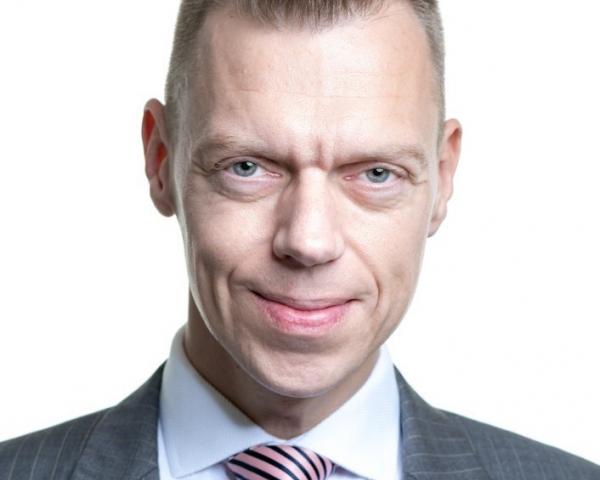A strategic inflection point, a term first used by then-Intel CEO Andrew Grove, is a period when an organization must respond to disruptive change in the business environment effectively or face deterioration – it’s typically illustrated by the S-curve of business development.
Strategic inflection points are changes that are more than 10 times more significant than typical market changes in the industry; one such clear example is the COVID-19 pandemic that has caused significant disruption to businesses and industries worldwide.
When a strategic inflection point occurs in the market, the companies must act to stay relevant or decline into obsolescence, risking either going completely out of business or ending up as an acquisition target for market players that made the jump onto the new S-curve successfully.
A major reason for companies not being able to make the required shift to the new S-curve is lack of awareness and knowledge in the executive management team; it takes a specific management style and set of competences to actively monitor, understand and act according to market changes.
This whitepaper addresses the management competencies required to successfully lead a company through a strategic inflection point.
The S-curve and why it matters
The S-curve model has proven itself time after time, and it has become clear that all companies, regardless of how successful they are today, at some point will run out of room to grow in their current business areas and trajectory.
There are many reasons for the stalling, from not understanding changes in customer behavior and preferences to sticking to the core competencies of the business (or holding on too long) to not executing and implementing required changes successfully.
In fact, there is less than 10% chance for companies to fully recover, once the company faces a major slowdown in the business (Olson and Bever, “Stall points”).
Faced with this fact, companies must be capable of reinventing themselves over time to stay relevant in the markets, and the S-curve provides an excellent tool to understand this and to help managers identify when it’s time to reinvent the company and jump onto the next S-curve.
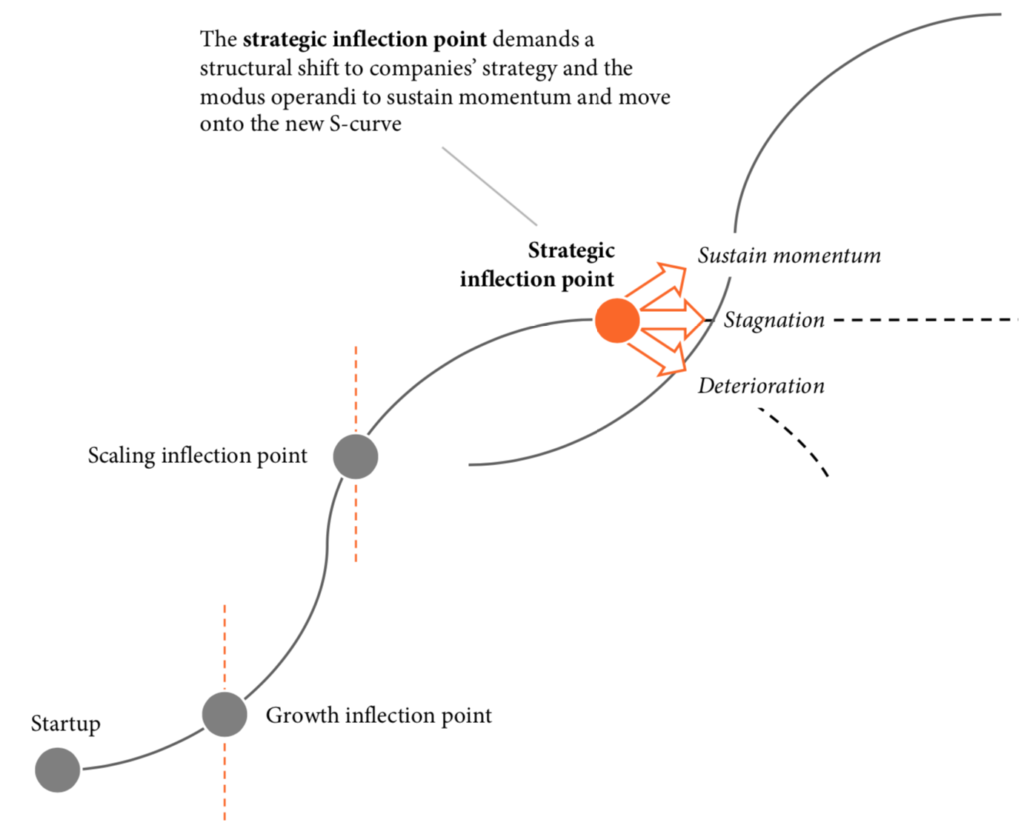
Companies rarely go out of business because they’re unable to fix what’s broken, but because they fail to realize (accept) that it actually is broken in due time. When business is "as usual" and management has been accustomed to slow growth – or even stagnating growth – complacency kicks in; “this is our industry, our business, we cannot do anything about it” while indeed management can!
This is where the S-curve becomes an invaluable – and refreshingly simple – tool to help companies understand the market development and enable them to react in time. That is, if the management knows what to do to plan and execute on the response to the changes.
In essence, the S-curve simply depicts the various stages of development of the company and – as history has shown – pretty accurately predicts what will happen next for the company. Analyzed correctly, the S-curve will act as a guide for management on the next strategic move.
Basically, the S-curve has three important inflection points that are necessary to understand:
Starting point
The starting point of the S-curve is where new product and services have just been introduced to the market and are waiting to be picked up. In this phase, the company will typically continue to be innovating the product and service features, testing the market reactions and adjusting the products and services based on the initial experiences with the customers.
During this stage, the company is extremely aware of market changes and focuses on staying agile and flexible enough to respond to these changes as quickly as possible.
Because the organization is fully tuned in on the innovation and development process, and market uptake may be initially slow, there is a risk that the teams become frustrated as growth is not happening fast enough to reward the hard work put into the innovation.
During start-up, management’s focus is on the product development process and how to secure best possible introduction to the market, including adjusting the organization to quickly respond to changes. The need for continuing changes and adjustments often results in less focus on profitability and scalability.
See also: COVID-19: Implications for Business Models
Growth inflection stage
When the new products and services are reaching a stage where they are aligned to market demand, the company will be able to scale and grow the (new) business. This requires scaling of the production and delivery processes and also demands a more structured approach to operating the business as a whole.
It is no longer feasible to sustain the preceding levels of corporate flexibility and agility as the company now has to produce and deliver at scale – often, standard operating procedures are introduced, and management will begin focusing on delivering the products and services while maximizing profits.
The teams will feel excited and inspired by the growth during this stage, and management will have to balance between keeping the motivation high and introducing standard ways of working to secure economies of scale and, through this, profit.
Strategic inflection point
Stagnating — or even declining — growth is a sign the company is approaching the strategic inflection point, the point where the company is forced to respond to disruptive change in the market.
At this point, the company has faced growth decline and management has therefore been focusing on optimization and cost-cutting, focusing on only the key value drivers and costs. This has led to a somewhat frustrated atmosphere in the organization as new initiatives and development typically has been put on hold because of financial constraints.
Unfortunately, many companies fail to realize (or accept) the strategic inflection point in time, allowing the disruption to happen at full scale and speed, further increasing the cost focus and sense of despair in the company.
It’s time to set out a new direction to put the company back on the growth trajectory – and this cannot be done by focusing on costs — there’s a need for a revitalized growth and business development mindset.
In the New Normal, all capabilities are required at the same time.
However, there’s still a need for focused cost control as the company would need to invest in the future growth and development, and there’s a need to align and optimize the operations to keep the business running during the period of reinvention and redesign of the products and services
Suddenly, all three management capabilities are required; the startup and business building capability, experience and competence in scaling and running operations effectively and cost optimization/restructuring capabilities.
Historically, companies are going through three phases in a cyclical manner, requiring various management capabilities depending on the phase the company is in.
During the growth and innovation/development phase, the primary management capabilities are innovation skills, company start-up experience, market proximity, abilities to see partnerships across industries and think in new value chains and distribution models.
Scaling a company up to cope with increasing demand requires operational experience, optimization capabilities and experience working with processes and process optimization, all connected through solid knowledge on organizational structuring to match the purpose.

Managing a stagnating company takes cost optimization capabilities, including knowledge on outsourcing/offshoring models to secure the company is running with as low a fixed cost base as possible – this frees cash to help the company through the stagnating period.
Sustaining momentum, moving from the current (old) S-curve to the new, requires all capabilities to be present. The leaders must be able to drive business innovation and development in uncharted waters as well as carrying out significant changes to the organization and processes to ensure scalability and effective processes and operations.
Adding to this, the manager must be capable of cutting costs and freeing as much capital as possible to ensure the needed funds for investing in the business innovation.
Focusing on costs, process optimization and organizational redesign will only keep the company on a stagnating route, leaving it as an attractive acquisition target for companies ready to innovate and invest in market and business development.
If leaders leave the company to doing business as usual at a strategic inflection point, the company will deteriorate and become obsolete over time.
Pulling yourself — and the team together.
It’s safe to say that most organizations – and insurers specifically – are at a strategic inflection point at this moment, and sustaining business momentum requires leadership that possesses all three capabilities, from growth over scaling to rationalization and optimization.
The fewest – if any – executives have all three capabilities as core competencies, so it is important for managers to understand their own competencies and, based on these, gather a team around them to make sure all required competencies and capabilities are present in the executive management team.
This chapter briefly highlights the leadership capabilities that are specifically required for each of the phases in the S-curve and is meant as a guide to a self-assessment as well as assessing the team members so it’s possible to create a dream team that collectively has all competencies required to secure the momentum of the company going forward.
Use Table 1 as a starting point for evaluating your own key competencies in the light of what’s required for the different S-curve phases and then do the same for the management team – ideally the combined capabilities should all be in the extensive proven experience column.
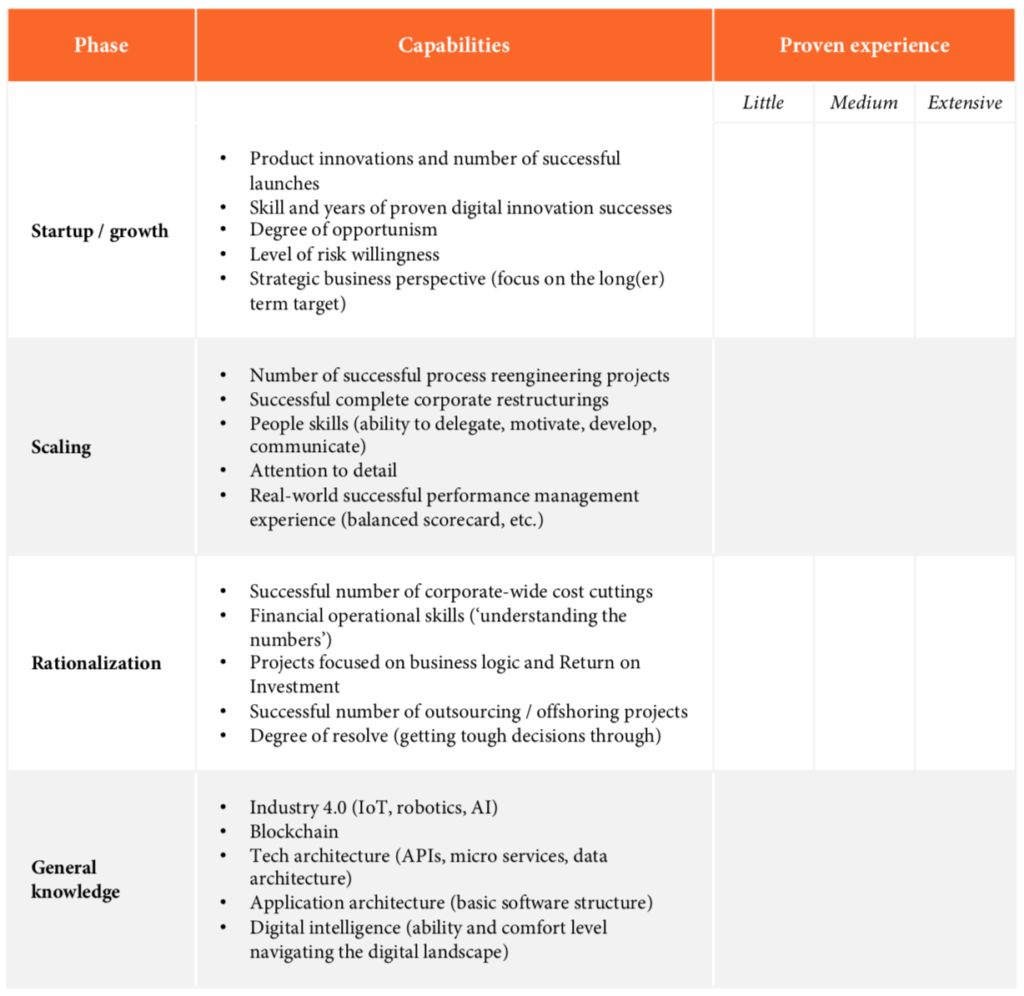
When the team has been identified and established, it is imperative that it is functioning as a cohesive unit, that all major decisions are made in agreement and that the entire leadership team agrees openly and uniformly in front of the employees.
A team that is not fully aligned risks losing the advantage of having all specific capabilities combined, and risks losing the trust of the employees, which will make the organizational change indefinitely more difficult.
Managing another gap — the lack of know-how.
In the New Normal, you cannot do as you did in the old normal, just harder. You need a new way of doing things, a new approach to strategy, to management and to your organizational construct.
The world at present – and according to all predictions in the future, too – will present companies and leaders with a situation of many unknowns and even unknown unknowns. There will be many moving parts that all need attention, and chances are that leaders will not be aware of how many of these will develop over time, let alone how to take action on the developments.
Faced with this, it is easy to become overwhelmed and experience action paralysis, a state where the vast amount of information – or the fact that there is no information – results in a sense of not knowing what to do.
Action paralysis can be extremely dangerous for the company, as managers experiencing this typically will focus on small details in the daily operations instead of grasping the big picture and working on a way forward to secure a future successful position for the company.
The known-unknown matrix is a valuable tool in creating an overview of the situation compared with what actions are required to be taken – it’s built around an axis of market outlook and development and an axis on actions to be taken as a function of the market development.
Both axes are split into what is currently known and what is unknown, and this mapping helps generate an overview and what’s required to get the sufficient knowledge on how to prepare and execute actions for the company.
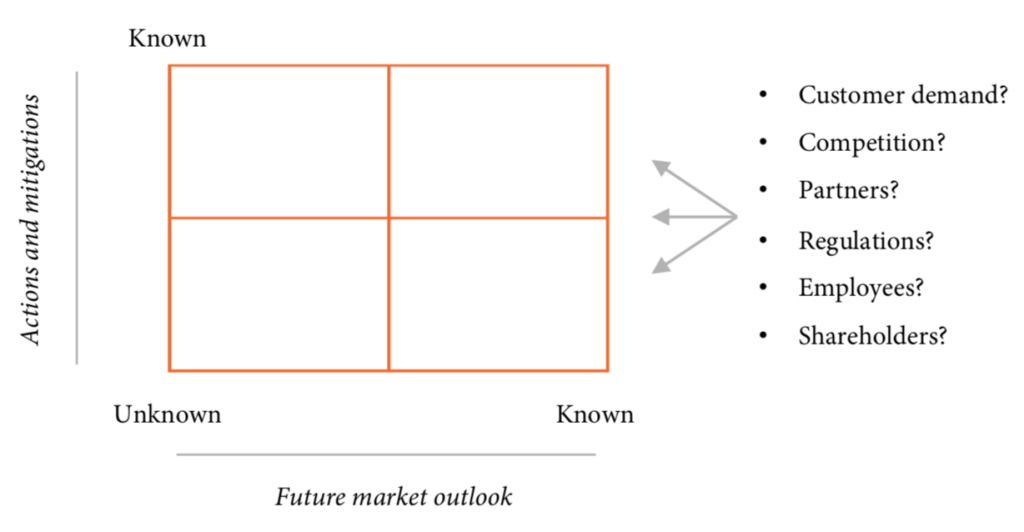
All eyes on you.
As executive, and especially during turbulent times, employees will look at you to seek guidance and comfort in the situation – it is an inherited human need to be comforted and feel safe, and employees will seek this from the executive management – and especially the CEO – of the company.
Executives must find ways of eliminating the many unknowns and unknown unknowns and turn the knowledge into specific actions and mitigations – this will be a vital part of becoming confident in setting the direction of the company, provide employees the guidance and comfort they seek and set the company on the course to success.
Using the known-unknown matrix will help creating the required overview of the situation and provide a plan for what to do next. As a starting point, areas of the business environment that should be mapped are shown in Table 2.
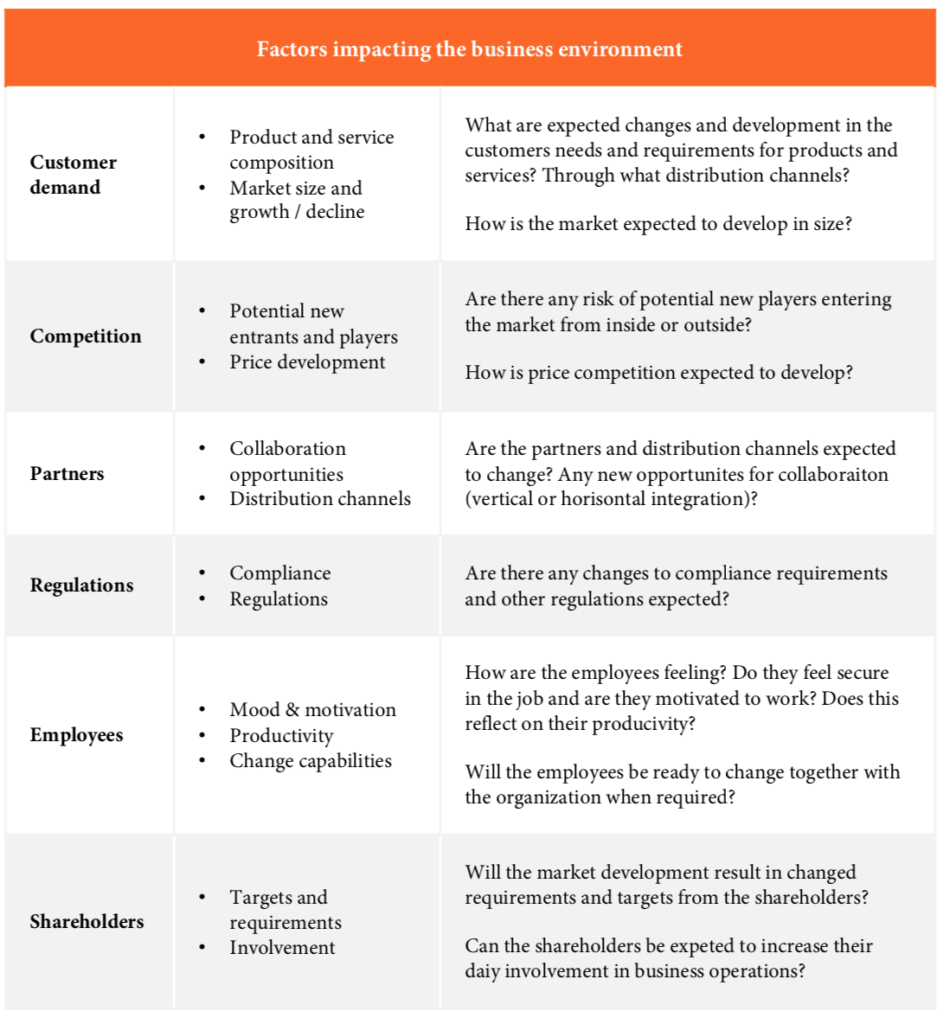
Start out by mapping the factors from Table 2 into the known-unknown matrix with your current levels of knowledge and resulting actions and mitigations.
The purpose of the exercise is to map out what is known and what is unknown so the unknown areas can be uncovered and actions planned – theoretically to move all unknowns into the known-known quadrant.
Don’t think you’re expected to know it all, but you’re expected to know what you don’t know and make decisions based on this, seek advice and guidance wherever and whenever you feel you’re outside your comfort zone.
It is important to seek information from credible sources, which can be anything from industry analysis from partners and via internet, as well as peer discussions within the industry and in near- field industries.

Acting on the known-unknown matrix
One dimension of the known-unknown matrix deals with market intelligence and predictions, and the other dimension is about management reactions, strategy, actions and implementation.
It should be the aim of managers to work on moving all important factors discussed above in Table X into the Execution quadrant of the known-unknown matrix as this will provide the knowledge required to take action.
Unknown unknowns – create scenarios
Factors that are in the unknown unknown quadrant are areas where there is not sufficient knowledge about the current and future market development and there is no experience or knowledge on how to take actions on possible outcomes.
Working with uncovering factors in this quadrant can be done through scenario planning where hypothetical developments in the markets are paired with corresponding management actions – there will therefore be created a mitigation from management in the case any of the market developments hypothesized is happening.

Unknown known
The building of scenarios are closely linked to the quadrant above, the ‘unknown market development, known actions’ as the scenarios are prescribing just that – “if this scenario happens, then we do this” – the difference is here that the leaders already have a set of mitigation actions ready, depending on the market development.
See also: COVID-19’s Impact on Delivery of Care
Known unknown
In the cases where the development/future outlook is known for the factors being analyzed, but actions to mitigate the developments are not, research into best practice management responses will go a long way in determining the actions required.
Execution
It is important to understand that when it comes to acting and executing on plans, two dimensions must be considered, knowledge- based and action-based executions.
Knowledge-based – understanding what to do
The knowing what to do is partly covered by the analysis made with the known unknown matrix and covers situation assessment as well as strategy and scenario building.
However, in understanding what to do, it’s crucial that the leaders hone their mental agility – their critical thinking skills and their comfort with complexity. In most cases, the actions required will be taken in unchartered waters, and the leader must appreciate this and be ready to dive into the unknown to execute the plans made.
Action-based – knowing how to do it
One thing is understanding what to do and preparing yourself to do so, another thing is to actually do it. It takes resolve to make the hard decisions and stand firm when (almost) all are against you.
To get things done, it is necessary to cut through the corporate political mess and make sure that the agreed-on actions are actually carried out – there will always be forces trying to work against the change.
Final thoughts
Changing an entire company in unknown times is an incredibly difficult task. However, it is important to remember that the task does not disappear by not responding to it and doing nothing.
This whitepaper covered important areas to be aware of and to understand in the current business environment and in preparing to compete under the New Normal – a new and unseen business environment that is expected to be volatile, uncertain, complex and virtual.
Responsible business leaders should take note of this and prepare themselves to lead their organizations through dramatic changes toward a new operating model and prepare themselves – and their organizations – for a world of constant change.
There will be no new stable business environment for the foreseeable future, and failure to adopt and adjust to this will be fatal for the long-term survival of the firm.
All journeys begin with a first step. I hope reading this was yours.
Good luck.



